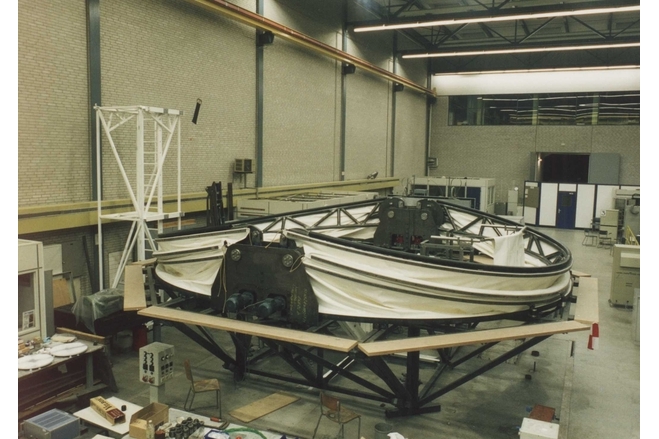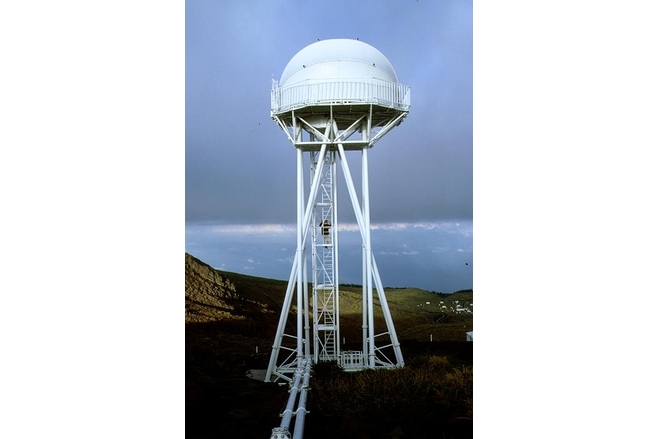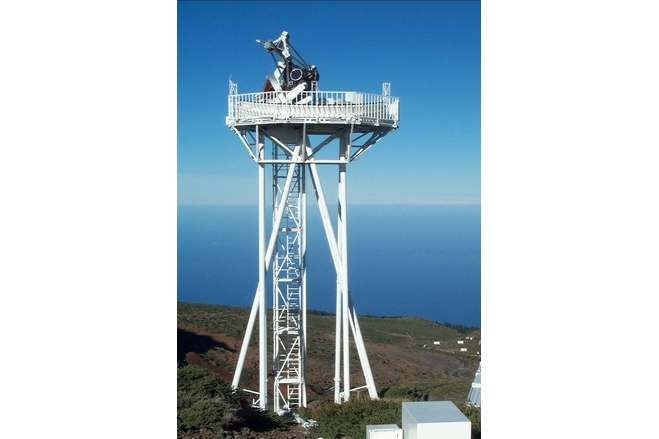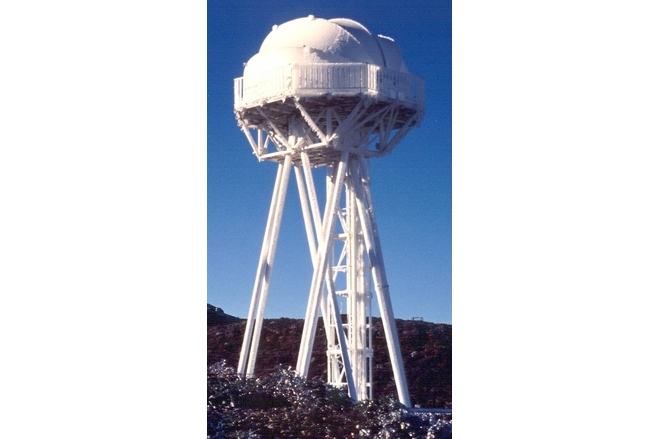Dutch Open Telescope (DOT)
General information
-
Location address
Observatorio del Roque de los Muchachos Canary Island La Palma
-
Location country
Spain
-
Name of the client/building owner
Astronomical Institute of the Utrecht University
-
Function of building
Laboratories & research centres
-
Climatic zone
Temperate - cold winters and mild summers
-
Type of application of the membrane
covering
-
Primary function of the tensile structure
- Rain protection
- Wind protection
Description
Telescopes have to operate in the open air without any objects nearby to reach the highest spatial resolution. Temperature fluctuations in the surrounding air, caused by nearby objects with slightly different temperatures, are the source of image deterioration.
Not only an open location but also the wind reduces the temperature fluctuations. Consequently, astronomical telescopes - often in mountain areas - have also to operate in hard wind. In case of rain, a surrounding cloud, ice deposition or storm (Figure 1), a protective enclosure has to be moved over the telescope.
A new solution is a foldable tent construction based on spanning the cloth between movable but still very stiff bows. The cloth parts are spanned in saddle shape for maximum stability against wind. Experiences with a first very experimental tent with a diameter of 7m for the Dutch Open Telescope (DOT) at a height of 2350m on the Canary Island La Palma are promising.
The design of the DOT-tent was a cooperation of the Astronomical Institute Utrecht and the Central Workshop DTO of the Delft University of Technology. The DOT-project in general was supported by a STW-grant. The Central Workshop in cooperation built the tent with several Dutch firms for the fabrication of essential parts like the tent-cloth, the rubber profile for the tent seal and the actuator units for moving the bows. Test assembly was at the workshop in Delft, see Figure 2a (for the tent closed) and Figure 2b (for the tent in an open position).
Figure 3 shows the tent closed on top of the DOT-tower at the observatory on La Palma. Figure 4 shows the tent open while the DOT is observing the sun. Figure 5 shows a close-up of the open tent around the DOT.
There was a lot of scepticism from the surrounding scientific world whether the DOT-tent would survive the severe weather situations that occur at the observatory on La Palma during wintertime. Now the tent is in safe operation for a couple of years, the scepticism changed into a serious interest in the tent construction. A larger tent of a diameter of 9m is in construction for a solar telescope with 1.5m diameter mirror on the Canary Island of Tenerife with similar weather conditions as on La Palma. A German consortium of solar research institutes will operate this telescope named Gregor. It will include several improvements compared with the DOT-tent, like double cloth for better isolation and improvement of the sealing around the ends of the bows with drive machinery. Also this larger tent is built by the cooperation of the Astronomical Institute Utrecht and the Delft University of Technology.
We are planning further development of this tent construction in two directions. First, there is interest in large tents of a diameter between 20 and 30m for larger telescopes, for instance a multi mirror solar telescope with an effective resolution of 10m. Second, further technical development of smaller tents such that they become a reliable construction at a reasonable cost. This requires a measuring program for getting more precise information about the loads and deformations both during opening and closing under strong wind and when closed under heavy storms, such as occur on mountaintops. It is expected, that the measuring results will lead to more precise calculations and important design improvements. We are looking for more contacts, which would be interested in these developments.
Description of the environmental conditions
Material of the cover
-
Cable-net/Fabric/Hybrid/Foil
Fabric
-
Material Fabric/Foil
Polyester
-
Material coating
PVC
Main dimensions and form
-
Maximum height (m)
3.5
-
Total length (m)
7
-
Total width (m)
7
-
Form single element
Anticlastic
-
Form entire structure
Synclastic
Duration of use
-
Temporary or permanent structure
Permanent
-
Convertible or mobile
Convertible
Involved companies
-
Contractors
-
Suppliers
Poly Nederland
Editor
-
Editor
Marijke M. Mollaert






